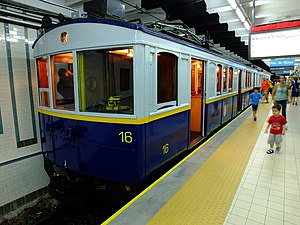This article has multiple issues. Please help improve it or discuss these issues on the talk page. (Learn how and when to remove these messages)
|
| La Brugeoise cars | |
|---|---|
 La Brugeoise train at Plaza de Mayo station. | |
| In service | 1913 – 2013 |
| Manufacturer | La Brugeoise, et Nicaise, et Delcuve |
| Built at | Bruges, Belgium |
| Constructed | 1911–1919, 1944 |
| Refurbished | 1927 |
| Number built | 125 cars |
| Number in service | 100 cars |
| Number preserved | 1 car (number 10) |
| Number scrapped | 21 cars (By 2012) |
| Formation | Maximum 6 cars per trainset (limited by platform length) |
| Capacity | 42 sitting + 120 standing |
| Operators | Metrovías |
| Depots | Polvorín workshop |
| Lines served | Line A |
| Specifications | |
| Car body construction | Wood |
| Car length | 15,800 mm (51 ft 10 in) |
| Width | 2,600 mm (8 ft 6 in) |
| Height | 3,380 mm (11 ft 1 in) |
| Doors | 3 pairs per side |
| Maximum speed | 50 km/h (31 mph) |
| Weight | 27 tonnes (27 long tons; 30 short tons) per car |
| Traction motors | Two "U 109" (one per bogie) |
| Power output | 115 hp (86 kW) |
| Electric system(s) | 550/1,100 V DC Overhead |
| Current collector(s) | one double-arm pantograph per car |
| Bogies | Two per car |
| Braking system(s) | Air brakes (regular and emergency purposes); manual mechanical brakes (emergency only) |
| Safety system(s) | Mechanical ATS; overhead lever (one per cab) |
| Track gauge | 1,435 mm (4 ft 8+1⁄2 in) standard gauge |
La Brugeoise cars were Buenos Aires Underground (Subte) Line A rolling stock since its inauguration in 1913 till 2013 when replaced by new Chinese stock. They were built by the Belgian railway rolling stock manufacturer La Brugeoise et Nivelles between 1911 and 1919 for the Anglo-Argentine Tramways Company's (Compañía de Tranvías Anglo-Argentina (CTAA) in Spanish) first underground line. They were originally designed to run both as metro and tramway cars, but they were refurbished in 1927 for underground use only. They became the oldest underground rolling stock in commercial service in the world [1] as well as a tourist attraction and part of Buenos Aires cultural heritage.
- ^ "La línea A avanza hasta los años ochenta". enelSubte (in Spanish). 30 November 2001.